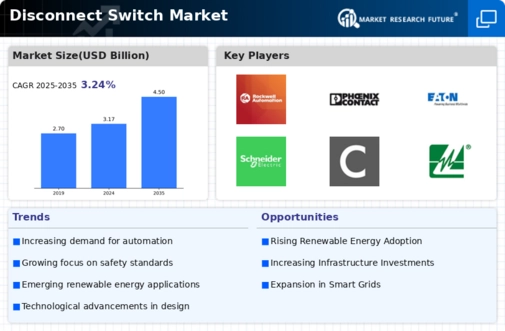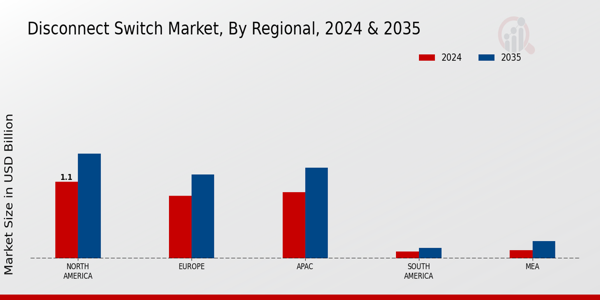Growth in Renewable Energy Projects
The Disconnect Switch Market is poised for growth due to the rising number of renewable energy projects. As countries strive to meet energy transition goals, investments in solar, wind, and other renewable sources are escalating. Disconnect switches are essential components in these systems, providing safety and operational reliability. The International Energy Agency has reported a significant increase in renewable energy capacity, which directly correlates with the demand for disconnect switches. This trend suggests that as more renewable energy projects come online, the Disconnect Switch Market will expand to accommodate the necessary safety measures and operational controls required in these installations.
Increasing Infrastructure Investments
The Disconnect Switch Market is experiencing a surge in infrastructure investments, particularly in developing regions. Governments and private entities are allocating substantial budgets to enhance electrical grids and distribution networks. This trend is driven by the need for reliable power supply and the integration of renewable energy sources. For instance, investments in smart grid technologies are expected to reach significant figures, thereby boosting the demand for disconnect switches. These devices play a crucial role in ensuring safety and reliability in electrical systems, which is paramount as infrastructure projects expand. As a result, the Disconnect Switch Market is likely to witness robust growth, with projections indicating a compound annual growth rate that reflects the increasing focus on modernizing electrical infrastructure.
Rising Demand for Safety and Compliance
The Disconnect Switch Market is significantly influenced by the increasing emphasis on safety and regulatory compliance. As industries face stricter safety standards, the demand for disconnect switches that meet these regulations is on the rise. Organizations are prioritizing the installation of reliable disconnect switches to mitigate risks associated with electrical failures. This trend is particularly evident in sectors such as manufacturing and utilities, where compliance with safety standards is critical. The market is expected to grow as companies invest in disconnect switches that not only comply with regulations but also enhance overall safety in their operations.
Expansion of Electric Vehicle Infrastructure
The Disconnect Switch Market is likely to benefit from the expansion of electric vehicle (EV) infrastructure. As the adoption of electric vehicles accelerates, the need for robust charging stations and related electrical infrastructure is becoming increasingly apparent. Disconnect switches are vital components in these systems, ensuring safe operation and maintenance. The growth of EV infrastructure is supported by government initiatives and private investments aimed at promoting sustainable transportation. This trend indicates a promising future for the Disconnect Switch Market, as the demand for reliable disconnect switches in EV charging stations is expected to rise significantly.
Technological Innovations in Disconnect Switches
Technological advancements are reshaping the Disconnect Switch Market, leading to the development of more efficient and reliable products. Innovations such as smart disconnect switches, which offer remote monitoring and control capabilities, are gaining traction. These advancements not only enhance operational efficiency but also improve safety standards in electrical systems. The integration of IoT technology into disconnect switches is particularly noteworthy, as it allows for real-time data analysis and predictive maintenance. This shift towards smarter solutions is likely to attract investments and drive growth within the Disconnect Switch Market, as stakeholders seek to optimize their electrical infrastructure.


















Leave a Comment